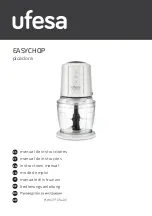
13
Operating Manual - PROTEA SYSTEM II 4.24D Distribution / System Processor
In addition to the frequency and slope, crossover filters can be selected as having Butterworth, Bessel, or
Linkwitz-Riley response. These refer to the shape of a filter's slope at the cut-off frequency, affecting the way two
adjacent pass bands interact at the crossover point. 24dB/octave Linkwitz-Riley filters produce a flat transition through
the crossover region, assuming both overlapping filters are set to the same frequency, slope, and response type. 24dB/
oct Linkwitz-Riley filters are the industry standard, the easiest to use, and the filter type recommended by Ashly.
Other filter types are available, but may require polarity switching or other adjustments for proper results. The follow-
ing paragraphs offer a summary of the three filter types as used in the 4.24C crossovers.
Butterworth
Butterworth filters individually are always -3dB at the displayed crossover frequency and are used because
they have a "maximally flat" passband and sharpest transition to the stopband. When a Butterworth HPF and LPF of
the same crossover frequency are summed, the combined response is 3dB. With 12dB per octave Butterworth
crossover filters, one of the outputs must be inverted or else the combined response will result in a large notch at the
crossover frequency.
Bessel
These filters, as implemented on the 4.24D, are always -3dB at the displayed crossover frequency. Bessel
filters are used because they have a maximally flat group delay. Stated another way, Bessel filters have the most linear
phase response. When a Bessel HPF and LPF of the same crossover frequency are summed, the combined response is
+3dB for 12dB/oct, 18dB/oct, and 48dB/oct Bessel filters, and -2dB for 24dB/oct Bessel filters. One of the outputs
must be inverted when using either 12dB/oct or 18dB/oct Bessel crossover filters or else the combined response will
have a large notch.
Linkwitz-Riley
The 12 dB/oct, 24dB/oct, an 48dB/oct Linkwitz-Riley filters individually are always -6dB at the displayed
crossover frequency, however the 18dB/oct Linkwitz filters individually are always -3dB at the displayed crossover
frequency. The reason for this is that Linkwitz-Riley filters are defined in terms of performance criterion on the
summing of two adjacent crossover HPF and LPF filters, rather than defined in terms of the pole-zero characteristics of
individual filters. The 18dB/oct Linkwitz-Riley individually are 18dB/oct Butterworth filters in that they have
Butterworth pole-zero characteristics and also satisfy the criterion for Linkwitz-Riley filters.
When a Linkwitz-Riley HPF and LPF of the same displayed crossover frequency are summed, the combined
response is always flat. With 12dB/oct Linkwitz-Riley crossover filters, one of the outputs must be inverted or else the
combined response will have a large notch at the crossover frequency.
7.4g Delay
In large installations or outdoor venues there are often many speakers in
various locations to get the best coverage possible. Since sound travels relatively
slow through air (1130 ft/s at 20ºC), multiple loudspeaker locations can create a
situation where the original audio signal, simultaneously leaving all loudspeakers,
arrives at a single point in the venue at several different times. Needless to say this
causes problems, and what may be crystal clear sound directly in front of any one
loudspeaker can be unintelligible at the farther reaches of the venue with direct line-
of-sound to multiple loudspeaker sources.
The solution is to delay the audio signal to the loudspeakers located further
away from the primary source, so that sound comes out of the distant loudspeakers at
the exact time that sound from the main loudspeakers arrives. Within the Protea
4.24D, up to 682 milliseconds of time delay are available on each output channel,
allowing secondary loudspeakers to be time aligned with the primary speakers up to
771 feet (235m) away.
Same sound arrives at
two different times.
Fix by delaying secondary
speakers 177mS.
Speaker on
Main Stage
Secondary Speaker
200 ft from Main Stage
Long Time Delay
For Remote Speakers






































